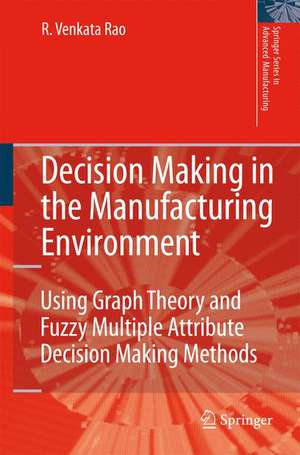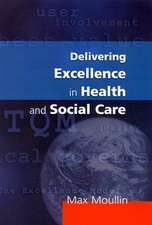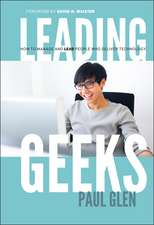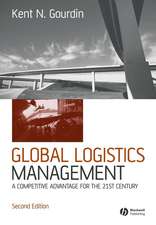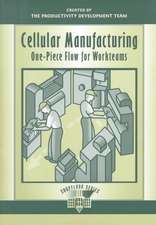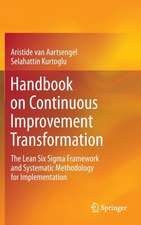Decision Making in the Manufacturing Environment: Using Graph Theory and Fuzzy Multiple Attribute Decision Making Methods: Springer Series in Advanced Manufacturing
Autor Ravipudi Venkata Raoen Limba Engleză Hardback – 19 iun 2007
This book shows how graph theory and matrix approach, and fuzzy multiple attribute decision making methods can be used in manufacturing. Part I introduces the decision making situations in the manufacturing environment and presents decision making methods; Part II uses case studies to illustrate the applications of these methods in real manufacturing situations.
This book will interest designers, manufacturing engineers, practitioners, managers, institutes involved in design and manufacturing related projects, researchers, academics, and graduates in this field.
| Toate formatele și edițiile | Preț | Express |
|---|---|---|
| Paperback (1) | 949.10 lei 6-8 săpt. | |
| SPRINGER LONDON – 28 oct 2010 | 949.10 lei 6-8 săpt. | |
| Hardback (1) | 955.08 lei 6-8 săpt. | |
| SPRINGER LONDON – 19 iun 2007 | 955.08 lei 6-8 săpt. |
Din seria Springer Series in Advanced Manufacturing
- 18%
 Preț: 1124.92 lei
Preț: 1124.92 lei - 18%
 Preț: 952.89 lei
Preț: 952.89 lei - 18%
 Preț: 1122.56 lei
Preț: 1122.56 lei - 17%
 Preț: 463.35 lei
Preț: 463.35 lei - 18%
 Preț: 1231.95 lei
Preț: 1231.95 lei - 15%
 Preț: 671.14 lei
Preț: 671.14 lei - 20%
 Preț: 691.51 lei
Preț: 691.51 lei - 18%
 Preț: 956.81 lei
Preț: 956.81 lei - 15%
 Preț: 632.37 lei
Preț: 632.37 lei - 20%
 Preț: 655.85 lei
Preț: 655.85 lei - 15%
 Preț: 636.94 lei
Preț: 636.94 lei - 18%
 Preț: 949.06 lei
Preț: 949.06 lei - 18%
 Preț: 1830.17 lei
Preț: 1830.17 lei - 19%
 Preț: 562.16 lei
Preț: 562.16 lei - 18%
 Preț: 1821.63 lei
Preț: 1821.63 lei - 18%
 Preț: 945.79 lei
Preț: 945.79 lei - 18%
 Preț: 949.10 lei
Preț: 949.10 lei - 18%
 Preț: 1552.01 lei
Preț: 1552.01 lei - 18%
 Preț: 1383.81 lei
Preț: 1383.81 lei - 18%
 Preț: 958.38 lei
Preț: 958.38 lei - 15%
 Preț: 639.25 lei
Preț: 639.25 lei - 18%
 Preț: 952.72 lei
Preț: 952.72 lei - 18%
 Preț: 945.79 lei
Preț: 945.79 lei - 15%
 Preț: 647.27 lei
Preț: 647.27 lei - 18%
 Preț: 945.92 lei
Preț: 945.92 lei - 18%
 Preț: 1215.99 lei
Preț: 1215.99 lei - 18%
 Preț: 1226.73 lei
Preț: 1226.73 lei - 18%
 Preț: 1840.43 lei
Preț: 1840.43 lei - 18%
 Preț: 1225.13 lei
Preț: 1225.13 lei - 18%
 Preț: 952.72 lei
Preț: 952.72 lei - 15%
 Preț: 634.68 lei
Preț: 634.68 lei - 15%
 Preț: 641.53 lei
Preț: 641.53 lei - 18%
 Preț: 947.35 lei
Preț: 947.35 lei - 18%
 Preț: 954.45 lei
Preț: 954.45 lei - 18%
 Preț: 951.77 lei
Preț: 951.77 lei - 15%
 Preț: 634.68 lei
Preț: 634.68 lei - 15%
 Preț: 636.94 lei
Preț: 636.94 lei - 18%
 Preț: 945.14 lei
Preț: 945.14 lei - 15%
 Preț: 638.89 lei
Preț: 638.89 lei - 18%
 Preț: 958.73 lei
Preț: 958.73 lei - 18%
 Preț: 1104.88 lei
Preț: 1104.88 lei - 18%
 Preț: 1226.73 lei
Preț: 1226.73 lei
Preț: 955.08 lei
Preț vechi: 1164.73 lei
-18% Nou
Puncte Express: 1433
Preț estimativ în valută:
182.78€ • 190.12$ • 150.89£
182.78€ • 190.12$ • 150.89£
Carte tipărită la comandă
Livrare economică 15-29 aprilie
Preluare comenzi: 021 569.72.76
Specificații
ISBN-13: 9781846288180
ISBN-10: 1846288185
Pagini: 392
Ilustrații: XVIII, 374 p.
Dimensiuni: 155 x 235 x 32 mm
Greutate: 0.72 kg
Ediția:2007
Editura: SPRINGER LONDON
Colecția Springer
Seria Springer Series in Advanced Manufacturing
Locul publicării:London, United Kingdom
ISBN-10: 1846288185
Pagini: 392
Ilustrații: XVIII, 374 p.
Dimensiuni: 155 x 235 x 32 mm
Greutate: 0.72 kg
Ediția:2007
Editura: SPRINGER LONDON
Colecția Springer
Seria Springer Series in Advanced Manufacturing
Locul publicării:London, United Kingdom
Public țintă
ResearchCuprins
to Decision Making.- to Decision Making in the Manufacturing Environment.- Graph Theory and Matrix Approach as a Decision- making Method.- to Multiple Attribute Decision-making (MADM) Methods.- A Logical Approach to Fuzzy MADM Problems.- Applications of GTMA and Fuzzy MADM Methods in the Manufacturing Environment.- Material Selection for a Given Engineering Application.- Evaluation of Product Designs.- Machinability Evaluation of Work Materials.- Cutting Fluid Selection for a Given Machining Application.- Evaluation and Selection of Modern Machining Methods.- Evaluation of Flexible Manufacturing Systems.- Machine Selection in a Flexible Manufacturing Cell.- Failure Cause Analysis of Machine Tools.- Robot Selection for a Given Industrial Application.- Selection of an Automated Inspection System.- Selection of Material Handling Equipment.- Selection of Rapid Prototyping Process in Rapid Product Development.- Selection of Software in Manufacturing Industries.- Welding Process Selection for a Given Application.- Geometric Moldability Analysis of Parts.- Evaluation of Metal Stamping Layouts.- Selection of Forging Conditions for Forging a Given Component.- Evaluation of Environmentally Conscious Manufacturing Programs.- Environmental Impact Assessment of Manufacturing Processes.- Evaluation of Aggregate Risk in Green Manufacturing.- Selection of Best Product End-of-Life Scenario.- Integrated Project Evaluation and Selection.- Facility Location Selection.- Operational Performance Evaluation of Competing Companies.- Vendor Selection in a Supply Chain Environment.- Group Decision Making in the Manufacturing Environment.
Recenzii
From the reviews:
Decision makers in the manufacturing sector frequently face the problem of assessing a wide range of alternative options, and selecting one based on a set of conflicting criteria. The book helps readers to understand and solve this important problem using graph theory, matrix-based approach and fuzzy multiple attribute decision making method. The approaches discussed in this book are very effective for decision making in various real-life situations of the manufacturing environment. The major salient feature of the book is its depth in covering many real manufacturing world applications (25 in total) of the proposed methods.
The complete basket of applications treated in Part 2 of the book reveals a holistic understanding of the manufacturing environment, which is quite heterogeneous and dynamic in nature. The methods presented in the book can be very useful to the decision makers in the manufacturing sector, as these methods make decision making easier, systematic, and effective. Furthermore, the methods can be used for solving any type of decision making problem in any field involving any number of alternative options and criteria.
It is apparent that the author has a full grip on the subject and therefore his treatment of the subject matter is sound and up to mark. This book is useful for both the first time readers in this area as well as those involved in high end research in multi-criteria decision making. The book is easy to read and follow. It has a very clear structure and message, focusing on key strategic topic of decision making in the manufacturing environment. The book is highly appropriate for designers, manufacturing engineers, managers, R&D organizations, academicians, and graduate and post-graduate students.
Ravi Shankar, Ph.D.
Associate Professor
School of Management
Asian Institute of Technology[T]he techniques presented in thisbook will be helpful to the decision makers employed in the manufacturing environment, as through their implementation the decision-making process should be made more systematic, simple, and effective.
The structure of the book is clear and easy to follow; although, from a reader’s perspective the book would have benefitted from a concluding chapter just to summarize the approaches and their implementations with the specific case studies. The author has targeted this book at graduate engineers and academics working with the manufacturing sectors. This aim has been accomplished, but because of the techniques presented, it is not going to be a ‘shop floor manual’ for all engineers. At present the book is expensive, but notwithstanding this book would be an asset in any academic establishment library or to an engineering manager’s book case.
Proceedings of the Institution of Mechanical Engineers, Part B: Journal of Engineering Manufacture 223 (2009) 1505 (Reviewer: J. Matthews)
Decision makers in the manufacturing sector frequently face the problem of assessing a wide range of alternative options, and selecting one based on a set of conflicting criteria. The book helps readers to understand and solve this important problem using graph theory, matrix-based approach and fuzzy multiple attribute decision making method. The approaches discussed in this book are very effective for decision making in various real-life situations of the manufacturing environment. The major salient feature of the book is its depth in covering many real manufacturing world applications (25 in total) of the proposed methods.
The complete basket of applications treated in Part 2 of the book reveals a holistic understanding of the manufacturing environment, which is quite heterogeneous and dynamic in nature. The methods presented in the book can be very useful to the decision makers in the manufacturing sector, as these methods make decision making easier, systematic, and effective. Furthermore, the methods can be used for solving any type of decision making problem in any field involving any number of alternative options and criteria.
It is apparent that the author has a full grip on the subject and therefore his treatment of the subject matter is sound and up to mark. This book is useful for both the first time readers in this area as well as those involved in high end research in multi-criteria decision making. The book is easy to read and follow. It has a very clear structure and message, focusing on key strategic topic of decision making in the manufacturing environment. The book is highly appropriate for designers, manufacturing engineers, managers, R&D organizations, academicians, and graduate and post-graduate students.
Ravi Shankar, Ph.D.
Associate Professor
School of Management
Asian Institute of Technology[T]he techniques presented in thisbook will be helpful to the decision makers employed in the manufacturing environment, as through their implementation the decision-making process should be made more systematic, simple, and effective.
The structure of the book is clear and easy to follow; although, from a reader’s perspective the book would have benefitted from a concluding chapter just to summarize the approaches and their implementations with the specific case studies. The author has targeted this book at graduate engineers and academics working with the manufacturing sectors. This aim has been accomplished, but because of the techniques presented, it is not going to be a ‘shop floor manual’ for all engineers. At present the book is expensive, but notwithstanding this book would be an asset in any academic establishment library or to an engineering manager’s book case.
Proceedings of the Institution of Mechanical Engineers, Part B: Journal of Engineering Manufacture 223 (2009) 1505 (Reviewer: J. Matthews)
Notă biografică
Dr R. Venkata Rao is a Professor and the Head of the Department of Mechanical Engineering at the Sardar Vallabhbhai National Institute of Technology, India. Dr Rao's research interests include advanced manufacturing technology, CAD/CAM, CIMS, fuzzy multiple attribute decision making methods, and non-traditional optimization methods.
Textul de pe ultima copertă
Manufacturing is the backbone of any industrialized nation. Recent worldwide advances in manufacturing technologies have brought about a metamorphosis in industry. Fast-changing technologies on the product front have created a need for an equally fast response from manufacturing industries. To meet these challenges, manufacturing industries have to select appropriate manufacturing strategies, product designs, manufacturing processes, work piece and tool materials, and machinery and equipment. The selection decisions are complex, as decision making is more challenging today. Decision makers in the manufacturing sector frequently face the problem of assessing a wide range of options and selecting one based on a set of conflicting criteria.
Decision Making in the Manufacturing Environment demonstrates how graph theory and matrix approach, and fuzzy multiple attribute decision making methods can be effectively used for decision making in various situations of the manufacturing environment. Divided into two parts; Part I introduces the decision making situations in the manufacturing environment and presents decision making methods; Part II uses case studies to present the applications of these methods in real manufacturing situations.
Decision Making in the Manufacturing Environment will be very useful to decision makers in the manufacturing sector as it makes decision making easier, more logical, systematic, efficient and effective. It is intended for designers, manufacturing engineers, practitioners, managers, institutes involved in design and manufacturing related projects, applied research workers, academics, and graduate students in mechanical, industrial, and manufacturing engineering.
Decision Making in the Manufacturing Environment demonstrates how graph theory and matrix approach, and fuzzy multiple attribute decision making methods can be effectively used for decision making in various situations of the manufacturing environment. Divided into two parts; Part I introduces the decision making situations in the manufacturing environment and presents decision making methods; Part II uses case studies to present the applications of these methods in real manufacturing situations.
Decision Making in the Manufacturing Environment will be very useful to decision makers in the manufacturing sector as it makes decision making easier, more logical, systematic, efficient and effective. It is intended for designers, manufacturing engineers, practitioners, managers, institutes involved in design and manufacturing related projects, applied research workers, academics, and graduate students in mechanical, industrial, and manufacturing engineering.
Caracteristici
Demonstrates how graph theory and matrix approach, and fuzzy multiple attribute decision making methods can be effectively used for decision making in various situations of the manufacturing environment Proposes a methodology that will make decision making in the manufacturing environment structured and systematic Uses case studies to present the applications of decision making methods in real manufacturing situations Includes supplementary material: sn.pub/extras
